DB Class 403 may refer to:
- DB Class 403 (1973), a train class in Germany (1973-1993)
- DB Class 403 or ICE 3, a high speed train class in Germany (since 1999)
DB Class 403 may refer to:

A tilting train is a train that has a mechanism enabling increased speed on regular rail tracks. As a train rounds a curve at speed, objects inside the train experience centrifugal force. This can cause packages to slide about or seated passengers to feel squashed by the outboard armrest, and standing passengers to lose their balance. Tilting trains are designed to counteract this by tilting the carriages towards the inside of the curve, thus compensating for the g-force. The train may be constructed such that inertial forces cause the tilting, or it may have a computer-controlled powered mechanism.

The Deutsche Bahn AG is the national railway company of Germany. Headquartered in the Bahntower in Berlin, it is a joint-stock company (AG). The Federal Republic of Germany is its single shareholder.

The Intercity Express is a system of high-speed trains predominantly running in Germany. It also serves some destinations in Austria, Denmark, France, Belgium, Switzerland and the Netherlands, mostly as part of cross border services. It is the highest service category of rail and the flagship train of the German state railway, Deutsche Bahn. There are currently 315 trainsets in use. ICE trains are the highest category trains in the fare system of the Deutsche Bahn. Their fares are not calculated on a fixed per-kilometre table as with other trains, but instead have fixed prices for station-to-station connections, levied on the grounds that the ICE trains have a higher level of comfort. Travelling at speeds up to 320 km/h (200 mph), they are tailored for business travellers or long-distance commuters and are marketed by Deutsche Bahn as an alternative to flights.
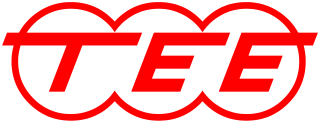
The Trans Europ Express, or Trans-Europe Express (TEE), was an international first-class railway service in western and central Europe that was founded in 1957 and ceased in 1995. At the height of its operations, in 1974, the TEE network comprised 45 trains, connecting 130 different cities, from Spain in the west to Austria in the east, and from Denmark to Southern Italy.

Siemens Velaro is a family of high-speed electric multiple unit trains built by Siemens and used in Germany, Belgium, France, the United Kingdom, the Netherlands, Spain, China, Russia, and Turkey. The Velaro is based on the ICE 3M/F high-speed trains manufactured by Siemens for the Deutsche Bahn (DB). The Deutsche Bahn were the first to order Siemens high-speed trains; it ordered 13 of these units in 1994, the Nederlandse Spoorwegen (NS) 4 units. The trains were delivered in 1999 for service. The trains were labeled and marketed as the Velaro by their manufacturer, Siemens.

In Germany, Luxembourg and Austria, the Regional-Express is a type of regional train. It is similar to a semi-fast train, with average speed at about 70–90 km/h as it calls at fewer stations than Regionalbahn or S-Bahn trains, but stops more often than InterCity services.

The Hanover–Würzburg high-speed railway was the first of several high-speed railway lines for InterCityExpress traffic that were built in Germany. While technically starting in the village of Rethen and ending at Würzburg Hauptbahnhof, it is a de facto link between Hanover and Würzburg, with stops at Göttingen, Kassel, and Fulda. Early construction started in 1973, the line opening fully in 1991.

The trainsets of Class VT 11.5 were diesel multiple units built by Deutsche Bundesbahn (DB) in 1957 and used for Trans Europ Express (TEE) services. Perceived as flagships of the DB rolling stock, they carried first-class seating only. When the UIC numbering scheme became effective on 1 January 1968, the power heads of the trainsets were renamed to Class 601 whilst the middle cars became Class 901 according to the DB locomotive classification. They were used for TEE service from 1957 until 1972 and thereafter on German InterCity services.

The DB Class 403 was a series of three electric multiple units commissioned by the Deutsche Bundesbahn in the 1970s, an early predecessor of the Intercity-Express as a high-speed train. The units were mainly used for InterCity services and again by the Lufthansa airline in the 1980s. Due to the distinctive design of its front section, the unit was nicknamed the "Donald Duck". They were designed for operational speeds of up to 220 km/h, a speed which was also attained in extensive test drives, but they were limited to 200 km/h in regular DB service.
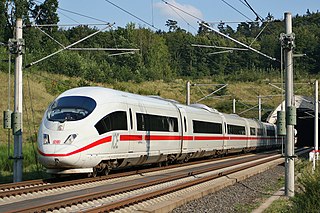
ICE 3, or Intercity-Express 3, is a family of high-speed electric multiple unit trains operated by Deutsche Bahn. It includes classes 403, 406,407 and 408, which are known as ICE 3, ICE 3M, New ICE 3 and ICE 3neo respectively. Three multisystem trains, known as ICE International, are owned by Nederlandse Spoorwegen. Based on the ICE 3M/F, Siemens developed its Siemens Velaro train family with versions used in Germany, Belgium, France, the United Kingdom, the Netherlands, Spain, China, Russia and Turkey.
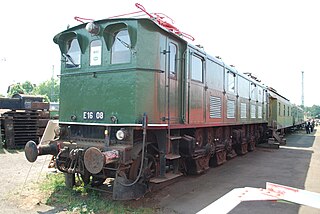
The DRG Class E 16 were German electric locomotives in service with the Bavarian Group Administration of the Deutsche Reichsbahn, and were conceived as motive power for express trains. They were initially designated as the Bavarian Class ES 1, before being incorporated into the DRG numbering plan as E 16.

The Bavarian Class EP 5 was an electric locomotive used for heavy passenger train services with the Deutsche Reichsbahn (DRG) and Deutsche Bundesbahn (DB).

DBAG Class 411 and Class 415 are German tilting electric multiple-unit high-speed trains in service with DB Fernverkehr, commonly known as ICE T.

The Spessart Ramp is a 5.4 km long incline on the Main-Spessart Railway in southern Germany between Laufach at one end and the Schwarzkopf tunnel and Heigenbrücken at the other, with an average incline of 20 ‰. The ramp is part of Ludwig's Western Railway and the section from Würzburg via Aschaffenburg to the state border at Kahl am Main was opened on 1 October 1854 by the Royal Bavarian State Railways. The ramp enabled the difference in height between the Laufach valley and the Lohr valley to be overcome as it crossed the Spessart between Kahl am Main and Aschaffenburg on the one side and Würzburg/Bamberg on the other.

A Schnellzug is an express train in German-speaking countries, where it refers to trains that do not stop at all stations along a line. The term is used both generically and also as a specific train type. In Germany and Austria it is also referred to colloquially as a D-Zug, a short form of Durchgangszug, and express train services were often given numbers preceded by the letter D. The similar term, snälltåg, was used in Sweden until January 1980.

Intercity is the second-highest train classification in Germany, after the ICE. Intercity services are loco-hauled express train services, usually over long-distances. There are Intercity routes throughout Germany, and routes generally operate with a two-hour frequency, with multiple routes giving a more frequent service on core routes. Intercity services are operated by the DB Fernverkehr sector of Deutsche Bahn.

The Class 430 EMU is an electric railcar for S-Bahn commuter networks in Germany, jointly developed by Bombardier and Alstom. The first trains went into service in 2012, replacing the Class 420 EMUs of the Stuttgart S-Bahn.
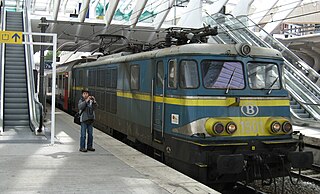
The Brabant was an express train that linked Gare du Nord in Paris, France, with Brussels-South in Brussels, Belgium. The train was named after the historical Duchy of Brabant of which Brussels was the capital.
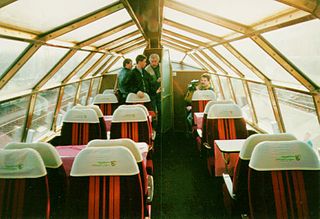
The Erasmus was an express train that linked The Hague, the Dutch seat of Government, with Munich in Germany. The train was named after the Dutch Renaissance humanist Desiderius Erasmus.

The Lufthansa Airport Express was an express train service in Germany, initially linking Düsseldorf and Frankfurt am Main Flughafen, and later Stuttgart too. The trains were operated by Deutsche Bundesbahn on behalf of the German airline Lufthansa, and with the airline providing the on-board customer service staff, and its use was limited to Lufthansa customers taking airplane flights into or out of Frankfurt or Düsseldorf airports.